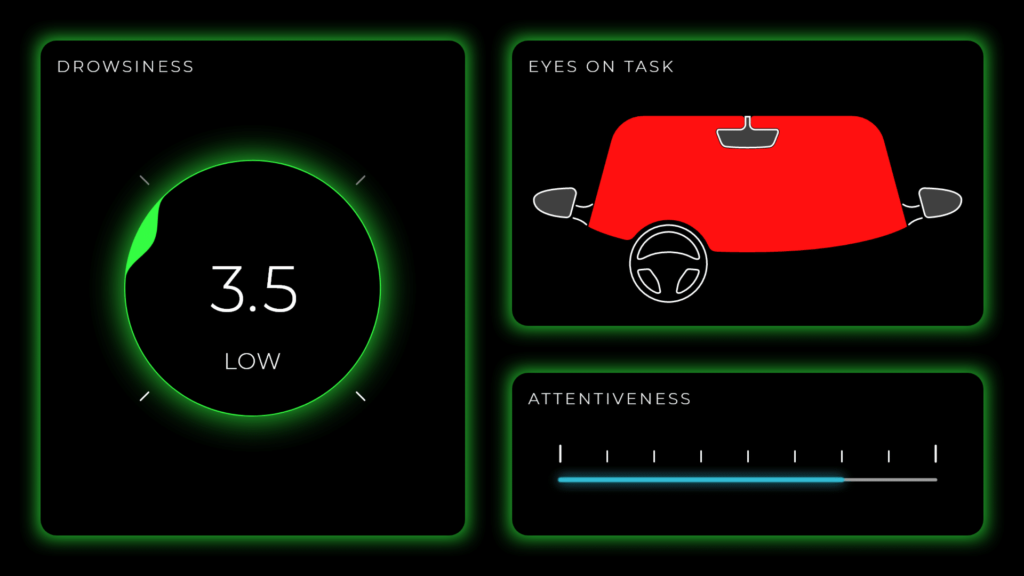Optalert is pleased to announce the availability of its latest driver monitoring software solution. Providing the most advanced measure of drowsiness & attentiveness in the automotive market, this gives Tier 1’s the ability to embed the technology directly into their driver monitoring systems (DMS).
The patented Optalert Johns Drowsiness Scale (JDS) provides a continuous numerical score of the driver’s impairment, so the system can provide the driver with early prediction of drowsiness and the ability to avoid dangerous microsleeps.
Utilizing a combination of sensors, software and algorithms, drivers can now be equipped with advanced warning of drowsiness and monitoring of their attentiveness through Eyes on Task (EoT) measurement. The output of the Optalert software, the driver drowsiness level (JDS score) can be used as an input to other vehicle systems for unparalleled safety and driver protection.

Protecting drivers better than ever before. Early detection is key.
Drowsiness
Optalert are world leaders in drowsiness detection technology. The scientifically validated technology has been used by industry, medical research and pharmaceutical drug trials and is supported by over 20 years of scientific research and publications.
Optalert technology is the only objective measure, capable of quantifying drowsiness through the real time measurement of eyelid movements. An early predictor of drowsiness, it is now complimented with attentiveness monitoring, to provide drivers with advanced warning of potential performance failure behind the wheel.

Attentiveness
Optalert’s monitoring of driver attentiveness goes beyond the minimal detection of the driver’s gaze being distracted from the road. Whether a driver is distracted by their mobile phone or looking in any direction other than the road ahead, the measure of EoT, can now be captured. When a driver’s attentiveness measurement encounters an exception, the driver can be signalled in order to avoid a collision or dangerous situation.
By customizing the measurement parameters to the specific environment of a vehicle, Optalert can monitor the attentiveness state of a driver by taking into account not only the driver’s activity but also the vehicle and surroundings. Speed of the vehicle, braking activity, external obstacles, dangerous sections of a road and lack of visibility caused by time of day or weather conditions are all factors that may be used to determine a minimal level of required attentiveness. Uniquely, Optalert’s attentiveness monitoring also factors in the drowsiness of the driver based on the JDS measure. In addition, an attentive driver does not always have their eyes on the road. Mirror checks and shoulder turns are all behaviours that may be penalized by a less sophisticated measure and potentially lead to false positive warnings.
Optalert’s attentiveness monitoring system is based on an EoT measurement state. This takes into account visually oriented tasks beyond the principal activity of keeping the driver’s eyes on the road. This also accounts for the peripheral vision and is a robust basis for the inclusion of external factors from an ADAS system. EoT profiles may be developed for any vehicle interior and scaled up according to the availability of external inputs. Beyond a time-based gaze warning it offers the ability to build a model of the driver’s true awareness of their dynamic situation, of controlling a motor vehicle in motion.
The Optalert state of the art system is transforming the way DMS can protect drivers at risk of drowsiness and inattentiveness. By combining precision technology and scientific algorithms, automakers are now able to incorporate the next generation of safety into their vehicles. Utilising driver monitoring technology, advanced image processing and scientific algorithms, Optalert’s leading edge technology enables the power to identify, track and ultimately protect drivers at risk earlier than ever before.

Euro NCAP Targets 2020, for implementing primary safety, driver monitoring standards.
NCAP proposes to reduce the significant problem of driver distraction and impairment through drowsiness, alcohol, etc. More than ninety percent of road accidents are caused by human errors. In general, the two most common errors observed are:
1) speeding and driving under the influence of alcohol or drugs and
2) human “errors”, in which the driver state – drowsiness, inattentiveness or distraction2
In an aging society, medical conditions are also a growing cause of road crashes. From deteriorating eyesight to developing early onset of dementia, drivers are increasing in need of greater protection for themselves and for others on the roads.
Evaluate the worlds most advanced drowsiness and attentiveness detection solution
Optalert’s automotive technical demonstration system is now available for Tier 1’s to evaluate.
Includes:
- Monthly rental option for flexible technology demonstration and evaluation
- Small footprint technology and easy installation
- Infrared illuminator – works with low light levels, darkness
- Advanced Image processing (Visage Technologies AB) – accurately and continuously tracks facial movements (http://visagetechnologies.com/)
- Patented Johns Drowsiness Scale (JDSTM) – Objective measure of drowsiness
- Eyes on Task (EoT) tracking – algorithm enables sophisticated measure of attentiveness
- Housing and mounting system – industrially designed, easy installation
- Software and Algorithm – adaptable to a variety of other camera systems
The focus of Optalert’s automotive road map is to develop leading edge, early warning, driver safety software.

Early warning is key to avoiding collisions
1 https://www.dmv.org/distracted-driving.php#The-Extent-of-the-Problem
2 https://cdn.euroncap.com/media/30700/euroncap-roadmap-2025-v4.pdf


